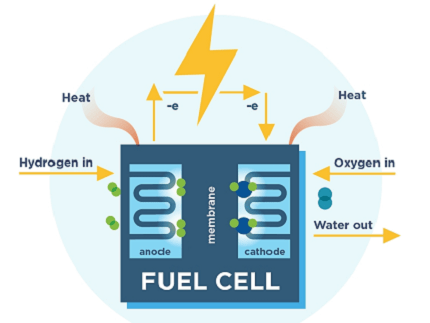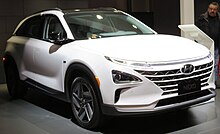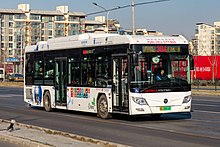
Fuel cells are electrochemical devices that convert the energy of a chemical reaction directly into electrical energy. They are considered a clean and efficient source of power since they do not produce any harmful emissions or pollutants, and can operate using a variety of fuels such as hydrogen, natural gas, methanol, and ethanol.
Fuel cells consist of an anode, a cathode, and an electrolyte. The anode is where the fuel (such as hydrogen) is introduced, and the cathode is where oxygen is introduced. The electrolyte separates the anode and cathode and allows charged particles (ions) to move between them.
When fuel is introduced at the anode, it is broken down into positively charged hydrogen ions and negatively charged electrons. The electrons are forced to travel through an external circuit, creating an electric current. At the cathode, oxygen is introduced, and it combines with the hydrogen ions and electrons to form water.
There are several different types of fuel cells, including proton exchange membrane (PEM) fuel cells, solid oxide fuel cells, alkaline fuel cells, and molten carbonate fuel cells. Each type has its own advantages and disadvantages, depending on factors such as fuel source, operating temperature, and application.
Fuel cells have a range of potential applications, including powering vehicles, providing backup power for buildings, and generating electricity for remote locations. However, there are still several challenges that need to be overcome, such as the high cost of producing fuel cells and the need for a reliable source of fuel.
Proton-exchange membrane fuel cell

Proton-trade film power modules (PEMFC), otherwise called polymer electrolyte layer (PEM) energy units, are a kind of power module being grown basically for transport applications, as well with respect to fixed energy component applications and versatile power module applications. Their distinctive highlights incorporate lower temperature/pressure ranges (50 to 100 °C) and a unique proton-leading polymer electrolyte film. PEMFCs create power and work on the contrary guideline to PEM electrolysis, which consumes power. They are a main possibility to supplant the maturing basic power module innovation, which was utilized in the Space Transport.
Fuel cell 1
A power device makes power utilizing the energy delivered by blending fuel in with air, a response which makes water and in some cases likewise carbon dioxide. The most well-known fuel for power modules is hydrogen, which when responded with oxygen from air creates just water. Energy components work like a battery being continually taken care of with fuel so it never runs out (as long as you have sufficient fuel). Power modules are a significant piece of the hydrogen economy. Hydrogen atoms are found in substances, for example, methane, water and biomass yet in all cases some energy is expected to extricate it. There are two familiar ways of creating hydrogen – it tends to be isolated from most powers like oil, gas, coal in a cycle called steam transforming, or it very well may be removed from water utilizing an interaction called electrolysis. Assuming the hydrogen is isolated from petroleum derivatives, carbon dioxide is delivered. Assuming the energy used to remove it from water through electrolysis comes from sun powered or twist, then the hydrogen created is harmless in light of the fact that no emanations are delivered. Hydrogen can likewise be isolated from inexhaustible biogas, and that implies the carbon radiated isn’t of fossil beginning and hence is important for the normal carbon cycle.
Home fuel cell
A home energy component or a private energy component is an electrochemical cell utilized for essential or reinforcement power age. They are like the bigger modern fixed energy units, however based on a more limited size for private use. These energy components are normally founded on consolidated intensity and power (CHP) or miniature joined intensity and power (Miniature CHP) innovation, creating both power and warmed water or air.
A financially working cell is called Eni-Homestead in Japan and is upheld by the territorial government, which utilizes gaseous petrol to drive up the power module to deliver power and warmed water.
Hydrogen fuel
Hydrogen fuel alludes to hydrogen which is singed as fuel with oxygen. It very well may be a zero-carbon fuel, given that made in a cycle doesn’t include carbon. However there are many sorts of hydrogen like green, blue, dark, dark or earthy colored hydrogen inferable from the different techniques for processes by which they stop by. It tends to be utilized in power modules or gas powered motors (see HICEV). Concerning vehicles, hydrogen has started to be utilized in business power device vehicles like traveler vehicles, and has been utilized in energy component transports for a long time. It is likewise utilized as a fuel for shuttle drive and is being proposed for hydrogen-controlled airplane. The fuel innovation has seen stirred interest from automakers who guarantee it is similarly modest and more secure to integrate into the advanced vehicle design over late difficulties looked by electric vehicle producers.
Fuel cell vehicle

2021 Toyota Mirai

2018 Hyundai Nexo

Foton BJ6123FCEVCH-1 fuel cell bus in operation
An energy component vehicle (FCV) or power module electric vehicle (FCEV) is an electric vehicle that utilizes an energy unit, once in a while in blend with a little battery or supercapacitor, to drive its locally available electric engine. Power devices in vehicles create power by and large utilizing oxygen from the air and compacted hydrogen. Most power module vehicles are delegated zero-emanations vehicles that radiate just water and intensity. As contrasted and inward ignition vehicles, hydrogen vehicles incorporate contaminations at the site of the hydrogen creation, where hydrogen is normally gotten from improved gaseous petrol. Shipping and putting away hydrogen may likewise make contaminations. Energy components have been utilized in different sorts of vehicles including forklifts, particularly in indoor applications where their perfect outflows are critical to air quality, and in space applications. Energy components are being created and tried in trucks, transports, boats, ships, bikes and bikes, among different sorts of vehicles.
The main street vehicle controlled by a power module was the Chevrolet Electrovan, presented by Broad Engines in 1966. The Toyota FCHV and Honda FCX, which started renting on December 2, 2002, turned into the world’s most memorable government-confirmed business power module vehicles, and the Honda FCX Lucidity, which started renting in 2008, was the world’s most memorable energy component vehicle intended for large scale manufacturing as opposed to adjusting a current model. In 2013, Hyundai Engines started creation of the Hyundai ix35 FCEV, professed to be the world’s most memorable efficiently manufactured power device electric vehicle, which was in this manner acquainted with the market as a rent just vehicle. In 2014, Toyota started selling the Toyota Mirai, the world’s originally devoted energy unit vehicle.
As of December 2020, 31,225 traveler FCEVs controlled with hydrogen had been sold around the world. Starting around 2021, there were just two models of power device vehicles openly accessible in select business sectors: the Toyota Mirai (2014-present) and the Hyundai Nexo (2018-present). The Honda Clearness was delivered from 2016 to 2021, when it was stopped. Starting around 2020, there was restricted hydrogen framework, with less than fifty hydrogen filling stations for autos freely accessible in the U.S. Pundits question whether hydrogen will be productive or savvy for cars, as contrasted and other zero discharge advancements, and in 2019, The Diverse Idiot thought: “What’s difficult to debate is that the hydrogen energy unit dream is everything except dead for the traveler vehicle market.”
Microbial fuel cell
An energy unit vehicle (FCV) or power module electric vehicle (FCEV) is an electric vehicle that utilizes an energy component, here and there in mix with a little battery or supercapacitor, to control its locally available electric engine. Energy units in vehicles create power by and large utilizing oxygen from the air and compacted hydrogen. Most energy component vehicles are delegated zero-outflows vehicles that produce just water and intensity. As contrasted and inside burning vehicles, hydrogen vehicles concentrate poisons at the site of the hydrogen creation, where hydrogen is normally gotten from improved flammable gas. Moving and putting away hydrogen may likewise make contaminations. Energy units have been utilized in different sorts of vehicles including forklifts, particularly in indoor applications where their spotless discharges are essential to air quality, and in space applications. Power modules are being created and tried in trucks, transports, boats, ships, cruisers and bikes, among different sorts of vehicles.
The primary street vehicle controlled by a power module was the Chevrolet Electrovan, presented by Broad Engines in 1966. The Toyota FCHV and Honda FCX, which started renting on December 2, 2002, turned into the world’s most memorable government-ensured business power module vehicles, and the Honda FCX Clearness, which started renting in 2008, was the world’s most memorable energy unit vehicle intended for large scale manufacturing as opposed to adjusting a current model. In 2013, Hyundai Engines started creation of the Hyundai ix35 FCEV, professed to be the world’s most memorable efficiently manufactured energy unit electric vehicle, which was in this manner acquainted with the market as a rent just vehicle. In 2014, Toyota started selling the Toyota Mirai, the world’s previously committed energy component vehicle.
Microbial energy unit (MFC) is a kind of bioelectrochemical power module framework that creates electric flow by redirecting electrons delivered from the microbial oxidation of diminished compounds (otherwise called fuel or electron giver) on the anode to oxidized mixtures like oxygen (otherwise called oxidizing specialist or electron acceptor) on the cathode through an outside electrical circuit. MFCs produce power by utilizing the electrons got from biochemical responses catalyzed by microorganisms. MFCs can be gathered into two general classifications: interceded and unmediated. The main MFCs, exhibited in the mid twentieth hundred years, utilized a go between: a substance that moves electrons from the microscopic organisms in the cell to the anode. Unmediated MFCs arose during the 1970s; in this sort of MFC the microbes commonly have electrochemically dynamic redox proteins, for example, cytochromes on their external film that can move electrons straightforwardly to the anode. In the 21st century MFCs have begun to track down business use in wastewater treatment.
FuelCell Energy
FuelCell Energy, Inc. is a public energy unit organization, settled in Danbury, Connecticut. It plans, makes, works and administrations Direct Energy component power plants (a sort of liquid carbonate energy component). The organization’s energy component innovation is an option in contrast to customary ignition based power age, and is reciprocal to discontinuous wellsprings of energy, for example, sun oriented and wind turbines. As one of the greatest public power module makers in the U.S., the organization gives clean energy in north of 50 areas everywhere. It works the world’s biggest power device park, Gyeonggi Environmentally friendly power Energy component park, which is situated in South Korea. The recreation area comprises of 21 power plants giving 59 Megawatt of power in addition to region warming to various clients in South Korea. It likewise works the biggest energy unit park in North America, comprising of five 2.8MW power plants and a rankine cycle turbine lining cycle in Bridgeport, Connecticut. Its client base covers business and modern ventures including service organizations, regions, colleges, and so on.